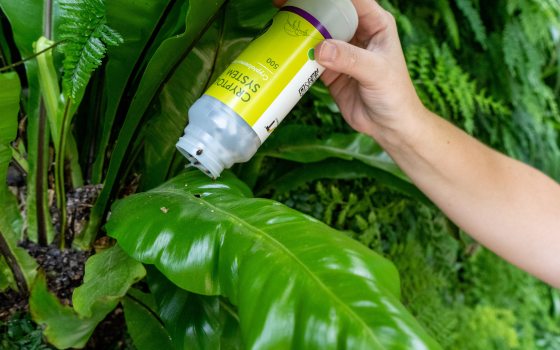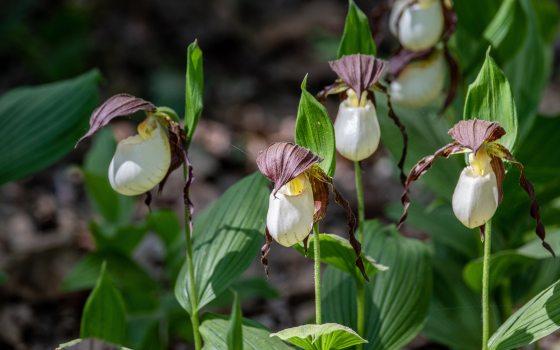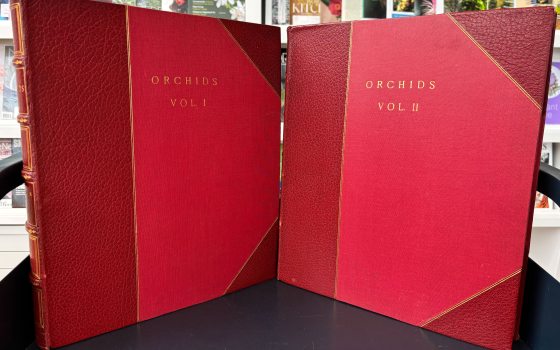For many, seeing insects in a garden may lead to initial alarm and raise questions about what harm those insects could inflict on the plants. Not all insects, however, are bad—in fact, here at Longwood, we regularly release beneficial insects in certain parts of our Gardens as part of our integrated pest management (IPM) program. By releasing these beneficial insects onto our Green Wall to our forested areas to our specialty chrysanthemum forms we grow each year for Chrysanthemum Festival, we’re able to help combat harmful pests and reduce the impact of those living organisms on our plants, people, and infrastructure using sustainable and effective practices. Follow along as we share how—and why—we release these tiny garden helpers.
The Longwood IPM team is responsible for diagnosing pest issues on plants residing in greenhouses, conservatories, and the outdoor gardens. Finding success in such a varied landscape lies in developing strong IPM programs that equally incorporate flexibility and preparation. We tackle a variety of pest issues on a variety of plants and within a variety of situations—and each situation requires unique tools. As the heart of our IPM program is flexibility, we must use a toolbox that has many different control options. We have to decide if it’s best to use chemical, biological, cultural, or mechanical controls, and we base each decision on pest pressure and the crop in question. The use of beneficial insects serves as a kind of biological control. In a nutshell, beneficial insects are simply “good” bugs eating “bad” bugs.
Spanning 4,000 square feet of lush, vertical vegetation, Our Green Wall serves as one of the most visible and regular places in our Gardens in which we regularly use beneficial insects. There, among the Green Wall’s variety of ferns, maidenhair, philodendron, spleenwort, and spider plants, we must combat such pest insects as aphids, whitefly, and mealybug. We have chosen the Green Wall as a location for beneficial insects for several reasons, the first being how permanent the Green Wall is. Beneficials do best in a location where they can reproduce and establish. In a location where the plants are only in place for a few weeks (unlike our Green Wall), the beneficials wouldn’t have adequate time to establish and reproduce. For the Green Wall in particular, it’s very important that the beneficials be able to reproduce and populate the space so they can spread out and get to the more vertical areas on the wall where our staff might not be able to reach as easily. This self-sustaining population helps combat pests and reduces the potential need for chemical control.

IPM Manager Beth Pantuliano releases beneficials at our Green Wall. Photo by Carol Gross.
Second, since the Green Wall is a more concentrated and somewhat isolated location within our Conservatory, the beneficials don’t travel much farther into the Conservatory. Some of our beneficial mites, for example, do not fly and can only spread from plant to plant if the leaves are touching. Some of our beneficial beetles can fly, but tend to stick to the Green Wall as long as there is enough food for them. Our IPM scouts inspect the Green Wall every other week to get an idea of which and how many pest insects are present. That way, we only order the beneficials that are truly needed.
We purchase our beneficials year-round and receive our beneficial insects in a box every other week. They are protected from hot delivery vehicles with an ice pack that helps regulate the temperature inside the box. When we receive our insects, we first like to move them to our IPM laboratory, which has a nice moderate temperature. After we’ve unpacked the insects, we decide on our release time. Just like people, insects don’t like to be immediately thrown into a really hot environment so we make sure we time our releases for early in the morning, especially during summertime. We only release them in greenhouses or Conservatory spaces that maintain temperatures at or above 45 to 50 degrees F.
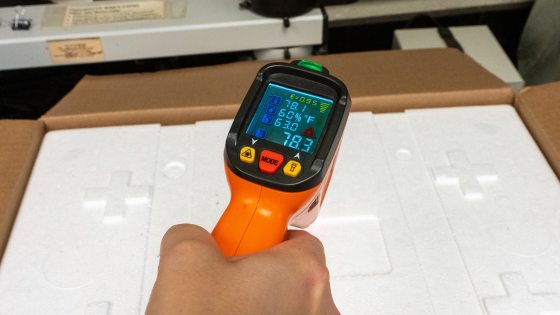
We take the temperature of the beneficials’ shipping box before unpacking it to ensure the box was not too hot during shipping. Photo by Carol Gross.
The “bad” bugs we target along our Green Wall, include aphids, whitefly, and mealybug. Aphids are typically clustered on the new growth or on the undersides of leaves; they’re pretty mobile and can be found anywhere on the plant. Some species even live in the root system underground. Signs of aphid presence include white shed skins left behind as they grow, a heavy presence of honeydew and sooty mold on leaves, plant curling and distortion, stunting of foliage, yellowed foliage, and reduced plant vigor. Aphids reproduce parthenogenically, so for most of their lives females are giving birth to clones of themselves—which means they can have a very quick generation time and can expand the population very quickly. Some aphids can even be born already pregnant.
The beneficial Aphidius Wasp targets aphids by detecting alarm signals of an affected plant and the smell of honeydew secreted by the host. This allows them to locate aphid hot spots from a long distance. In response, the female parasitic wasps prick the aphids and lay about 100 eggs in the aphids—most of them during the first four days of their adult life. One parasitic wasp can parasitize—or infest an organism as a parasite—up to 300 adult and nymph aphids, and can cause a panic reaction for the aphids, from which the aphids fall onto the ground and die.
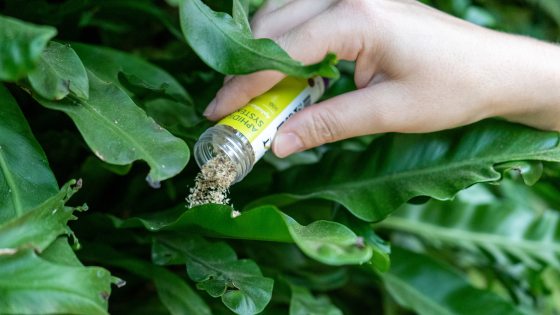
Beneficial Aphidius Wasps are sprinkled onto the Green Wall. These beneficials are shipped as parasitized “mummies”. The Aphidius has parasitized the aphid by laying her egg inside of it and the larvae hatches out. It feeds inside of the aphid and kills the aphid, and the aphid will become slightly puffy or mummified and turn gold in color. The adult Aphidius will chew its way out of the mummy, leaving a hole. We are shipped the mummies and the adult wasp will emerge from the mummy and find new prey to feed on. Photo by Carol Gross.
Another “bad” bug we can see along our Green Wall is the whitefly, typically found on the underside of leaves or flying around the plant. Signs of whitefly presence include overall lack of plant vigor or, in instances of high infestations, yellowing leaves and dropping leaves. Whitefly lay small oval eggs attached to the underside of the leaves, which hatch in six to 10 days. That hatches out into a flat oval crawler, which will settle into a spot to feed and remain there for 16 days to a month while going from crawler to nymph to pupa. When adult whitefly emerge, they will leave behind empty pupal casings on the leaves. The life stages of this insect overlap so you may get all life stages present at once. This process takes 21 to 36 days depending on temperature. We use beneficial Encarsia Formosa and Eretmocerus eremicus wasps against whitefly. The female beneficials prefer to prick the young larvae and then suck them, which is called host feeding, and parasitize the whitefly larvae from the second to fourth stage.
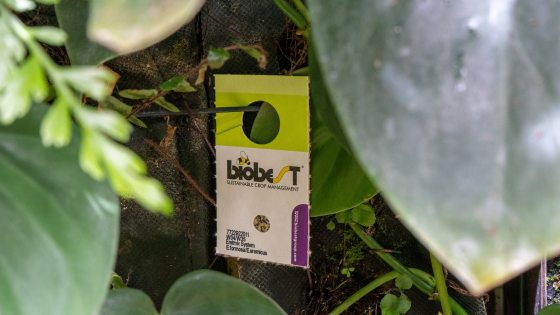
These cards, found on our Green Wall, are how the Encarsia Formosa and Eretmocerus eremicus are shipped. They are shipped as pupae and 50 to 100 pupae are on the little circle in the center of the card.. Photo by Carol Gross.
The mealybug is another unwanted bug in our Green Wall. It’s a pretty cryptic insect, as they like to hide in the plant. They have also been known to hide under rims of pots, and sometimes are bold enough to sit on the leaves of plants. Signs of mealybug presence include an overall lack of plant vigor, residual mealybug wax on the plants, stunting, defoliation, and honeydew and sooty mold. The adult mealybug lays up to 600 eggs at a time (except for longtail, which give live birth). Eggs hatch in three to 16 days on average. They pass through three to four nymphal stages before becoming adults. The first of these stages is small oval and yellow and is referred to as the crawler. This process lasts from six weeks to two months depending on conditions. Females die typically five to 10 days after laying eggs. Males are small and winged and short-lived; they also frequently have no mouthparts to feed on plants.
We use the beneficial Crypotlaemus montrouzieri, or mealybug destroyer, against them. The beneficial adults are good fliers with good search capability, and the beneficial larvae are covered in white waxy threads to mimic the mealybugs. Adult mealybugs and old mealybug larvae prove the most voracious, consuming 30 to 70 prey a day. Adults and young larvae prefer mealybug eggs and young mealybugs, while adult larvae feed on all stages of the mealybug. Female beneficials can lay up to 400 eggs in mealybug hot spots.
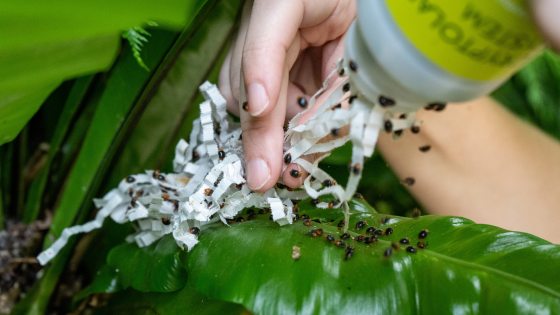
Beneficial adult Cryptolaemus montrouzieri make their way to the Green Wall. Photo by Carol Gross.
Our use of beneficial insects expands beyond our Green Wall. Just this summer, we partnered with the US Department of Agriculture-Agricultural Research Service to release three Emerald ash borer parasitoid wasps in various locations throughout our Gardens: Spathius galinae, Tetrastichus planipennisi, and Oobius agrili. It is our goal that these parasitoids—which are very small and will not harm people—will establish healthy population levels and help to diminish the Emerald ash borer throughout our forested areas, as they have decimated tens of millions of ash trees throughout the northeastern United States, typically killing a tree three to five years after infestation. In Pennsylvania, it was first found in 2007 and is now in every county in the state. Starting in spring 2023, we will monitor the presence of the different wasp species by placing bolts that contain Emerald ash borer larva around our ash tree stands and checking those bolts weekly. If there are beneficial wasps present, the larva will be parasitized. This monitoring will help dictate how many more beneficial wasps need to be released over the next few years.

Emerald ash borer parasitoid wasps, pictured in our Gardens. This image shows the small size of these beneficials. Photo by Becca Manning.
This year, we started releasing beneficials on some of the specialty chrysanthemum forms we nurture and train for our annual Chrysanthemum Festival. We chose to use beneficials on the chrysanthemums for a few reasons, the first being the longevity of the crop. We grow some of our specialty mums for well over a year! That length of time gives the beneficials plenty of time to get established. Second, the specialty chrysanthemums forms can have a very low pest tolerance, as just a few thrips or spidermites can damage or distort the flowers and leaves. Using beneficials allows us to have pest control in hard-to-reach places, such as developing flower buds or hard-to-reach leaves.
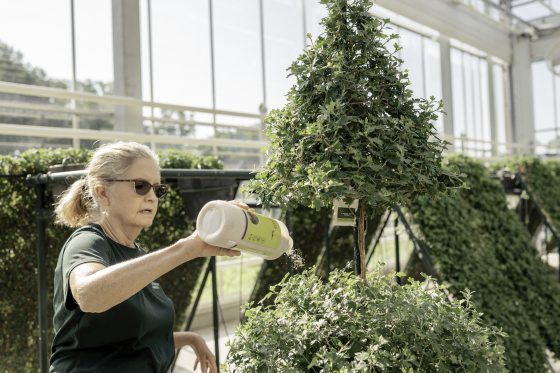
Here, Volunteer Joan Down releases beneficials on our in-process specialty chrysanthemum forms. We use a lot of the same beneficials for our specialty mums as we do on the Green Wall. Just like the Green Wall, our scouts pay special attention to pest levels each week and customize the beneficial release according to which pests are present in the growing houses. Photo by Meghan Newberry.
Next time you’re visiting us, take a closer look at the Green Wall and you may just see some of our beneficials hard at work, keeping our plants healthy, vigorous, and beautiful.
